Down the drain is where British archaeologists recently discovered 36 artfully engraved semiprecious stones, in an ancient bathhouse at the site of a Roman fort near Hadrian’s Wall in Carlisle, England. The colorful intaglios — gems with incised carvings — likely fell out of signet rings worn by wealthy third-century bathers, and ended up trapped in the stone drains.
The delicate intaglios, fashioned from amethyst, jasper and carnelian, range in diameter from 5 millimeters to 16 millimeters — bigger than a pencil eraser, smaller than a dime. Some bear images of Apollo, Mars, Bonus Eventus and other Roman deities symbolizing war or good fortune. Others showcase Ceres, the god of fertility, Sol (the sun) and Mercury (commerce). One amethyst depicts Venus holding either a flower or a mirror. A reddish-brown jasper features a satyr seated on rocks beside a pillar.
How and why these stones were lost is a subject of some debate among classicists. After six years of archaeological detective work that has provided a tantalizing glimpse of Roman Britain, Frank Giecco, the technical director of the Carlisle project, believes that he and his team have solved the mystery.
My Semiprecious
Historically, two kinds of engraved gems were worn mounted on finger rings: intaglios, which have designs cut as a depression into the surface of the gem; and cameos, with designs that project from the background, a raised image in relief.
The tradition of intaglios goes back to the Sumerian period in Mesopotamia, where figures were gouged by hand into softer stone. From about 3400 B.C., stamp seals and cylinder seals were pressed and imprinted into damp clay. These became popular in Minoan and Mycenaean Greece, Persia, Egypt and Rome, where they became objects of fashion; the statesman Cicero observed that people wore portraits of their favorite philosophers on their rings, a tradition that has not survived on today’s QVC Network.
To the Bathhouse
The excavation at the Carlisle Cricket Club began in 2017 and quickly revealed a bathhouse that “was truly colossal in scale,” Mr. Giecco said.
The bathhouse was built along the river Eden and near the Roman fort of Uxelodunum, also known as Petriana, which was safely situated behind Hadrian’s Wall, the empire’s northern border. Hadrian, the Roman emperor, ordered the wall built in 122 A.D. to ward off Caledonian tribes. At Uxelodunum — today a thriving suburb — were stationed the Ala Petriana, a large and elite cavalry regiment. A major civilian settlement — eventually Luguvalium, or Roman Carlisle — grew up to the immediate south.
The main building of the bathhouse, constructed around 210 A.D., had sandstone walls three-and-a-half feet thick. The baths were rebuilt in the fourth century and were still in use in the fifth; some parts were subsequently rebuilt in timber and may still have been standing in the 12th century, when the site was quarried for building materials. The region remained strategic. “We have found evidence of the 1645 and 1745 sieges of Carlisle during the English Civil War and Jacobite Rebellion,” Mr. Giecco said. In the early 20th century the site was turned into tennis courts.
Watch Your Valuables
Upon entering the bathhouse in the third century, your first stop was the apodyterium, or changing room, where you removed everything but your bath sandals, needed to protect your feet from the heated floors. Prosperous patrons had slaves to guard their belongings; poorer bathers paid the attendants. Some may have held onto their baubles in the pools to prevent the valuables from being stolen. “Bathers knew the risk of gems falling out,” Mr. Giecco said. “But theft from the lockers was so great that they kept valuables with them regardless.”
If a thief made off with your jewelry, you might call on the gods for justice, by means of a curse tablet: a priest would scrawl a message, sometimes backward or in code, on a slab of lead or other metal, then cast it into the mineral waters. In 1979 and 1980, a large haul of curse tablets was recovered from the hot springs of Aquae Sulis — now Bath, England — many of them listing the wrongdoing, the alleged wrongdoers and a suggested punishment. “May he who carried off Vilbia from me be as liquid as the water,” one curse reads.
Becoming Unglued
The Carlisle gems were found along with more than 700 items, including 105 glass beads, pottery, weapons, coins, clay figures, animal bones, tiles stamped with the imperial mark and some 100 hairpins. Similar discoveries have been made during the excavation of bathhouses in Caesarea, Israel, and in Bath.
The presence of hairpins suggest that the gems’ owners were probably female, Mr. Giecco said. And dips into bathhouse water may have loosened jewelry adhesives, such as birch bark resin, and caused metal settings to expand and contract. In the steamy environment, the Roman elite may have emerged from their leisurely baths unadorned. The stones were likely flushed into the drains when the pools and saunas were cleaned.
“The bathers may not have even noticed until they got home, because it’s the actual stone falling out of the rings,” Mr. Giecco said.
Source: Read Full Article
